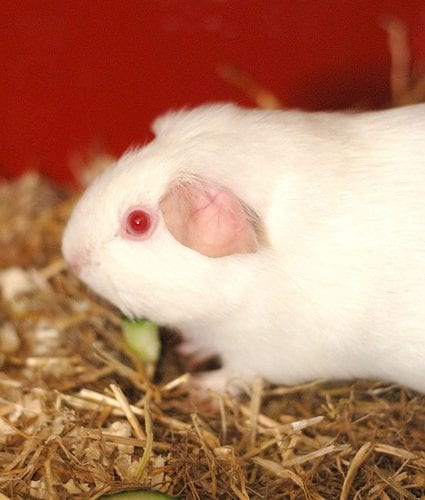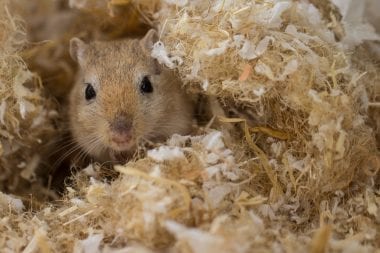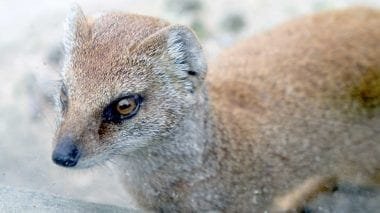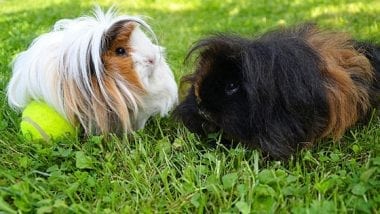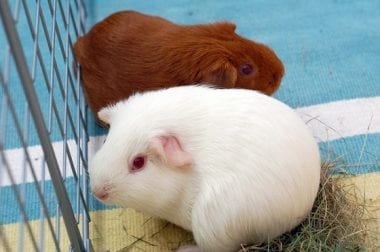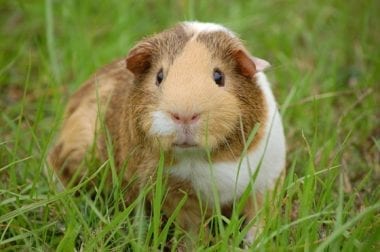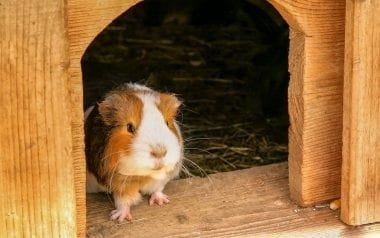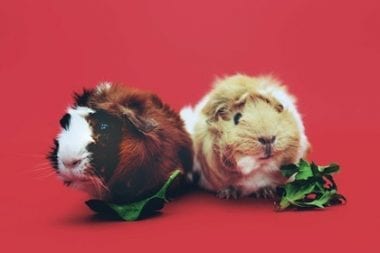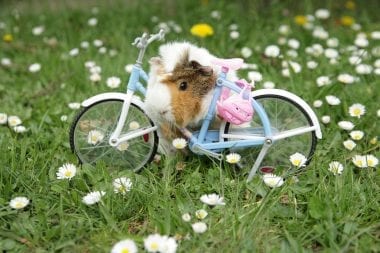Guinea pigs are extremely cute, snuggly, and fun family pets. Their lifespans are usually longer than those of other rodents and small animals even reaching the age of 8. When you first bring these fluffy critters to your home, you may not realize how frequently you’ll need to clean their cage. You may also not know how you’ll need to clean your guinea pig(s) and their cage. It’s obviously simple enough to believe ‘clean them when they’re dirty’ but what exactly does that entail? At what point should the litter be changed? Or the bedding? At what point should the toys be cleaned? What is the best way to clean a guinea pig and how often should they be cleaned? Guinea pig owners have a lot of questions and things to learn, and this article aims to cover all of those things.
So put your doubts to rest and yourself at ease, because this article thoroughly aims to cover all these things. Everything has been broken down and simplified in a way that is easy for readers to understand. After reading this entire article, you’ll completely understand and know how to make your guinea pigs’ environment safe, clean, and good for their health! Your precious furballs will be able to run, dig, and play to their hearts’ desires!

Make your Guinea Pig Comfortable
1. Restraining the guinea pig
This is done by placing your hand around the guinea pig’s chest gently, keeping the thumb below the jaw of the guinea pig. Using your other hand, support the hind part of the guinea pigs’ body and hold the guinea pig upright using both hands. The guinea pig should be held firm enough to be secure. Be careful not to hold firmer than since it may injure the guinea pig. Be cautious of a squirmish, skittish, and anxious guinea pig. It may try to break free from your hold and jump, which may cause serious injuries.
2. Removing the guinea pig
When the guinea pig has been restrained correctly, take it out from its cage. Keep it in a safe, enclosed area where it will not be able to escape free. Make sure you have someone else around you (such as a family member, neighbor, roommate, friend, etc). You will need them to be present to keep a watch on your guinea pig. Ensure there are no loud sounds near your guinea pig’s enclosure, as these may be frightening for the guinea pig. You may have someone around you who can hold your guinea pig properly while you clean. This is especially useful if you don’t have a temporary and safe enclosure to keep your guinea pig in when you have to clean your guinea pig’s cage.
Good temporary enclosures that you can use are well-ventilated pet transport carriers or a box with an open lid (necessary for the guinea pig to breathe!). The box should be deep/tall enough that the guinea pigs don’t jump outside it and flee!
3. Giving your guinea pig its ‘hiding house’
Your guinea pig must have become accustomed to having its own hiding place in its permanent cage. Your guinea pig may have gotten anxious after being removed from its cage. If you are not able to remove and fit your guinea pigs’ hiding house into its temporary enclosure, fear not piggie parents! You can then you can cut a hole in the bottom of a cardboard box through which the guinea pig will enter, exit, and breathe. This will help comfort your guinea pig and you too can let go of worry.
Daily Cleaning of the Guinea Pigs Cage
1. Spot cleaning
Spot clean your guinea pig’s cage daily. Get rid of any excess food or waste in the cage. For spot cleaning use a wet paper towel as you require. Bedding soiled by your guinea pig needs to be scooped out and replaced by dry bedding.
2. Replenish food and water
You need to do this every single day. Often guinea pigs may soil the food in their food dish with water from the water dish. They may also drop food into the water dish. All such food and water must be removed and replenished.
3. Cleaning the food and water dish
These dishes must be cleaned with hot water and soap. Doing this will thoroughly clean them and disinfect them from bacteria that may grow on it. You don’t want your house to smell or your guinea pig getting sick, do you? Then wash and scrub away for a fresh-smelling home and healthy, happy guinea pigs!
Weekly Cleaning of Your Guinea Pig’s Cage
1. Planning and Scheduling
Make a plan and schedule a deep extensive cleaning of your guinea pig’s cage weekly. While daily spot cleaning and dish cleaning is important, weekly deep cleaning is required to keep your guinea pig healthy and happy. It’s also a must for keeping your home free of odor!
2. Empty the cage
Remove everything from the cage. All the toys, water bottles, food dishes, and hiding places must be removed. After all, how are you going to manage to do a good cleanup while keeping everything intact? You won’t be able to cover the entire area of the cage nor clean the individual items in the cage without removing them from the cage.
3. Washing the water bottle and food dish
A common occurrence with guinea pigs is how they manage to get their droppings into the food dishes! You would obviously understand how important it is to clean that up. Guinea pigs end up getting their bedding into their bowls and dishes as well.
Empty any leftover food and water from the dishes and water bottle. Let some hot water run from the sink, then submerge all these items into the hot water. Let them dry inside the sink, in the meantime, and continue to clean the cage.
If it’s possible to remove the hiding house in your guinea pig’s cage, then give it a wash too. You wouldn’t want your guinea pig to hide in a dirty place, would you?
4. Get Ready to Clean the Cage
Take the cage(and yourself!) to an appropriate cleaning location with ample space to move around and clean.
Get a large garbage bag and brace yourself, piggie parent! You’re going to be cleaning out EVERYTHING! You need to carefully brush all the substrate material of your guinea pig’s humble abode into the large garbage bag. If you have a large cage, you can use a cat-poop, dog-poop, etc scooper which is larger and intended for larger animals. However, it must NOT be the same scooper you borrowed from your dog or cat’s litter box!
5. Cage Spraying
You can use a mild detergent or you make your own cage cleaning concoction! Mix one part distilled white vinegar and three parts warm water and you’ve created your own cage cleaning concoction. Do you prefer to make something different that serves the same purpose? Well, you’re in luck, you’ve got another option dear guinea pig owners. Add half a cup (1/2 cup) of bleach to a gallon of water. If you want a smaller amount keep this proportion intact.
Did your sweet little guinea pigs make a mess or stain that’s too deep to clean with the distilled white vinegar solution? Then don’t add water! Use undiluted vinegar without the three parts water. However, vinegar has a strong smell that really irritates noses. It’s not only your nostrils you need to keep in mind, but your little piggies as well! So be sure to thoroughly rinse off the vinegar after you’re done cleaning with it. Keep rinsing until the smell goes away!
Regardless of whichever disinfectant you’ve chosen and sprayed, remember to let it rest for ten whole minutes without rinsing. Let the disinfectant do its work and serve its purpose properly. This will make sure that bacteria and other harmful disease-causing microbes are killed. It goes without saying that this is absolutely essential to keep your guinea pig healthy, happy, and safe. This also translates to a happy guinea pig owner and a home devoid of odor!
6. Rinsing the cage
After you’ve let the disinfectant rest on the cage surface for ten minutes, rinse it off thoroughly. Rinse every cage surface with hot water, and make sure all remnants and residues of the disinfectant get removed completely. Remember the cage is not considered clean until it’s spotless!
7. Drying the cage
You can let your cage air dry if you have the time, and of course, the patience. However, there’s no need to fret if you don’t have any one of them or even both! Go ahead and whip out the paper towels! Keep wiping and patting down every surface of the cage until it is completely dry. Completely dry means no moisture at all, not even a little. Ensuring complete dryness of the cage before laying down any bedding is crucial because even the slightest amount of moisture or dampness can facilitate the growth of mold. This in turn can make your guinea pig ill. That’s not what any pet parent would want for their beloved floof. So keep this in mind when you dry after cleaning!
After completing all the steps of cleaning and drying, line your guinea pig cage with the bedding of your choice. You may use newspaper, hay, or fleece liners (note: these can be washed by hand or in the washing machine). Avoid pine and cedarwood shavings or chips as lining, as these contain harmful chemicals (phenols) for your guinea pig. They are marketed and sold in pet stores as bedding, so it may be easy to forget. But for the sake of your precious piggies, keep this in mind.
Return your guinea pig’s items and your guinea pig itself to the cage, and watch your guinea pig scurry about happily in its freshly cleaned cage!
